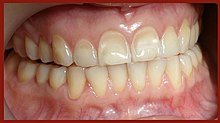| Acid erosion | |
|---|---|
| Other names | Dental erosion |
 | |
| An example of severe dental damage due to acid erosion. | |
| Specialty | Dentistry |
| Complications | Oral infection, tooth decay, tooth loss, xerostomia |
Acid erosion is a type of tooth wear. It is defined as the irreversible loss of tooth structure due to chemical dissolution by acids not of bacterial origin.[1] Dental erosion is the most common chronic condition of children ages 5–17,[2] although it is only relatively recently that it has been recognised as a dental health problem.[3] There is widespread ignorance of the damaging effects of acid erosion; this is particularly the case with erosion due to consumption of fruit juices because they tend to be seen as healthy.[4] Acid erosion begins initially in the enamel, causing it to become thin, and can progress into dentin, giving the tooth a dull yellow appearance and leading to dentin hypersensitivity.[5]
The most common causes of erosion are acidic foods and drinks. In general, foods and drinks with a pH below 5.0–5.7 have been known to trigger dental erosion effects.[6] Numerous clinical and laboratory reports link erosion to excessive consumption of such drinks. Those thought to pose a risk are soft drinks, some alcohol and fruit drinks, fruit juices such as orange juice (which contain citric acid) and carbonated drinks such as colas (in which the carbonic acid is not the cause of erosion, but citric and phosphoric acid).[7] Additionally, wine has been shown to erode teeth, with the pH of wine as low as 3.0–3.8.[6] Other possible sources of erosive acids are from exposure to poorly regulated chlorinated swimming pool water,[8] and regurgitation of gastric acids.[9] In children with chronic diseases, the use of medicines with acid components is a risk factor too.[10] Dental erosion has also been recorded in the fossil record and was likely caused by the consumption of acidic fruits or plants.[1]
- ^ a b Towle I, Irish JD, Elliott M, De Groote I (September 2018). "Root grooves on two adjacent anterior teeth of Australopithecus africanus" (PDF). International Journal of Paleopathology. 22: 163–167. doi:10.1016/j.ijpp.2018.02.004. PMID 30126662. S2CID 52056962.
- ^ ten Cate JM, Imfeld T (April 1996). "Dental erosion, summary". European Journal of Oral Sciences. 104 (2 ( Pt 2)): 241–4. doi:10.1111/j.1600-0722.1996.tb00073.x. PMID 8804892.
- ^ Dugmore CR, Rock WP (March 2004). "A multifactorial analysis of factors associated with dental erosion". British Dental Journal. 196 (5): 283–6, discussion 273. doi:10.1038/sj.bdj.4811041. PMID 15017418.
- ^ "'Health juices' harm baby teeth". BBC News Online. 2 August 2007. Retrieved 2009-05-21.
- ^ Guignon, Anne (September 2013). "Dental Erosion: An Increasingly Common Cause of Dentin Hypersensitivity" (PDF). Colgate Dental Aegis. Archived from the original (PDF) on 2021-04-29. Retrieved 2018-01-03.
- ^ a b Mandel L (January 2005). "Dental erosion due to wine consumption". Journal of the American Dental Association. 136 (1): 71–5. doi:10.14219/jada.archive.2005.0029. PMID 15693499.
- ^ Moynihan PJ (November 2002). "Dietary advice in dental practice". British Dental Journal. 193 (10): 563–8. doi:10.1038/sj.bdj.4801628. PMID 12481178.
- ^ Buczkowska-Radlińska J, Łagocka R, Kaczmarek W, Górski M, Nowicka A (March 2013). "Prevalence of dental erosion in adolescent competitive swimmers exposed to gas-chlorinated swimming pool water". Clinical Oral Investigations. 17 (2): 579–83. doi:10.1007/s00784-012-0720-6. PMC 3579418. PMID 22476450.
- ^ Paryag A, Rafeek R (September 2014). "Dental Erosion and Medical Conditions: An Overview of Aetiology, Diagnosis and Management". The West Indian Medical Journal. 63 (5): 499–502. doi:10.7727/wimj.2013.140. PMC 4655683. PMID 25781289.
- ^ Nunn JH, Ng SK, Sharkey I, Coulthard M (June 2001). "The dental implications of chronic use of acidic medicines in medically compromised children". Pharmacy World & Science. 23 (3): 118–9. doi:10.1023/A:1011202409386. PMID 11468877. S2CID 7071706.